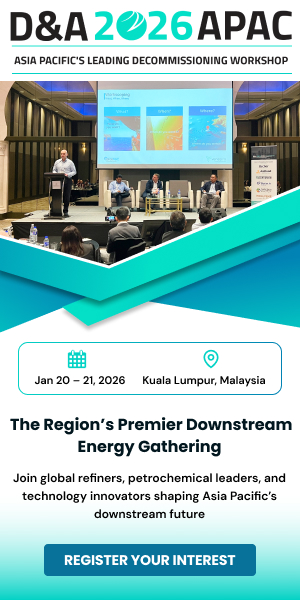
Muhammed Nadeem, SVP, Yokogawa UAE Industry and head of energy & sustainability at Yokogawa Middle East & Africa. (Image source: Yokogawa)
Muhammed Nadeem, SVP, Yokogawa UAE Industry and head of energy & sustainability at Yokogawa Middle East & Africa, speaks to Oil Review Middle East about the company’s focus at ADIPEC and its commitment to the UAE, where it has had a presence for almost 30 years
Nadeem begins by commenting on the role of ADIPEC in setting the tone for innovation, and the alignment of Yokogawa’s values and founding principles with those of the UAE and the region – ie of AI and innovation; sustainability; and localisation.
“If we talk about AI or innovation, I would like to refer to our purpose – "Utilising our ability to measure and connect, we fulfill our responsibilities for the future of our planet," he says. This is guided by Yokogawa’s corporate brand slogan, "Co-innovating tomorrow," and involves a commitment to solving social and environmental issues through its core competencies in measurement, control, and information technology.
“On sustainability, Yokogawa focuses on three goals – well being, net zeroing and circular economy,” he continues, “and when it comes to in-country value, we are committed to contributing to the societies where we operate.”
Progressing autonomous operations
Discussing Yokogawa’s recent successes on the innovation and AI front, he shares that in the UAE Yokogawa has conducted three proof of concepts (POCs) for its new FKDPP technology, an autonomous control AI protocol that makes use of reinforcement learning technology. It can control and autonomise areas of plant operations that have up to now necessitated manual operation. Nadeem notes that these have led to potential savings and value additions in net zeroing, energy management as well as quality and safety, given the elimination of the requirement for human intervention and therefore of human error and subjectivity. One of these POCs is for an AI-powered autonomous control room for Borouge’s Ruwais facility, where Yokogawa is using AI-based technologies to analyse data, identify patterns, and predict anomalies, enabling faster corrective actions and reducing unplanned shutdown risks. The POC is also exploring how autonomous control room operations can enhance efficiency and plant performance.
“We have had similar successes recently in Saudi Arabia as well,” Nadeem adds, referring to the implementation at the Fadhili gas plant, where Yokogawa has successfully deployed multiple autonomous control AI agents working together to autonomously control and optimise acid gas removal (AGR) operations at the plant. Initial results demonstrate a 10% to 15% reduction in its amine and steam usage, around 5% reduction in power usage, improved process stability, and a significant decrease in operator manual intervention, despite ambient condition changes. “The client is very happy with the ROI,” he comments.
This combination of multiple AI involves not only agents but also some of the drivers, such as robotics. “If you can send machines into an oilfield which has a lot of sulphur content, you can save lives,” he stresses.
He adds that Yokogawa is no longer a control company but an autonomous company, as reflected in its mission statement, and is system agnostic.
Evolution of AI
On the progress of AI, Nadeem comments that we have passed the “crawling” stage and are on the “walk to run” phase. Referring to the opening remarks at ADIPEC of Dr Sultan Al Jaber, UAE Minister of Industry and Advanced Technology and CEO of ADNOC, he said, “People understand that without AI, as Dr Al Jaber said today, you will be nowhere. You cannot ignore it. We have moved beyond the proof of concept stage to proof of value. In fact, we are actually on the borderline between proof of value and full-flight deployment. Yokogawa has moved beyond proof of value – we are now talking about the reoccurring model, where we have already given the concept the value and it is now running. I go back to what Dr Al Jaber said this morning; we are not here to give the vision or the dream, we are here for delivery. Because the vision without the action will be hallucination – we have to deliver it.”
He adds that the shared vision and commitment of the NOCs and IOCs to AI and innovation has supported Yokogawa’s drive to put R&D and manpower resources into AI developments.
“We are very proud that our leadership has recognised that this region is at the heart not only of energy development but also innovation. So we have established our Centres of Excellence for AI, robotics and cyber security in this region, to serve the whole globe. Not in Japan, not in Europe, not in the USA but in Abu Dhabi and Dammam. This will help not only our clients but also our ability to grow and devote all our energy to the right direction.”
Turning to sustainability, he comments that this is often a natural by-product of innovation around safety and quality, as these technologies will also lead to sustainability.
“Sustainability can involve multiple goals, but let’s take for example wellbeing. If people are assisted by AI they can have a good work/life balance, right? If they are using AI, they can be more productive. Another example is energy management, where energy management savings contribute to sustainability. Well being and net zero are all built in if you go with the right products, and the right partners like your product.”
On localisation, Nadeem reiterates that one of Yokogawa’s founding values is contributing to the societies in which it operates, and that the region’s in-country value initiatives tie in with Yokogawa’s vision and founding values. “We were operating locally even before the establishment of the UAE’s ICV and Saudi Arabia’s IKTVA initiatives,” he points out. “Since 2009 we have been operating all our control system cyber security out of Abu Dhabi, Dammam, or Bahrain or Qatar, from wherever the customers are. And we are not only talking about establishing our own centres, but doing all our life cycle management out of our local centres in the region, from engineering design, to testing, delivery and after service. So we are walking the walk, not just talking the talk.”
Key message at ADIPEC
Returning to the company’s focus at ADIPEC, Nadeem says Yokogawa’s key message aligns with the ADIPEC theme of energy, intelligence and impact. “We all require energy, and to repeat one of the themes of the opening, we are not talking about energy transition but about energy addition. So we are working on renewables and hydrogen alongside our traditional oil and gas business. This is one of our key themes for this edition of ADIPEC. Then on the AI and innovation theme, we are talking about robotics and Yokogawa Chat GPT, where we help operators with their decision making, and thirdly, we are looking at circular economy, net zeroing and wellbeing. And we are now moving beyond proof of concept and proof of value to deployment.
“I’m very excited as I have taken part in ADIPEC for the past 25 years, and I was saying to some of our young people here, I don’t see it just as an exhibition and event, as I see innovations launched here becoming reality in the future. ADIPEC is creating not only the dialogue, but also the delivery.”









